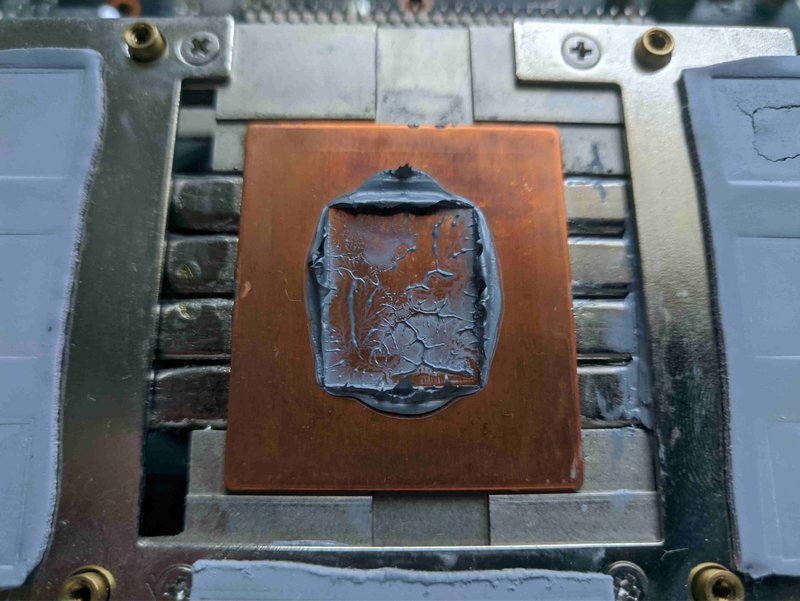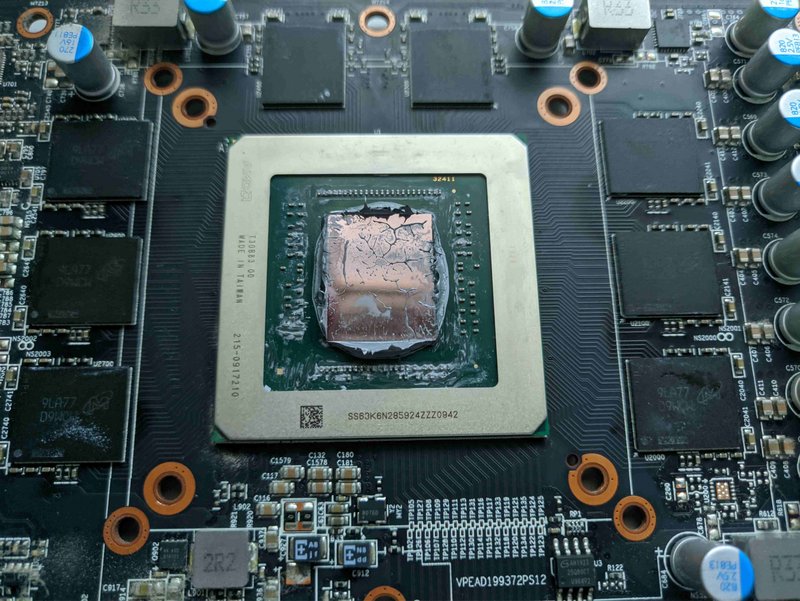Hi everyone!
Can you please help me with this thermal paste application issue that I'm having? My GPU model is a XFX 5700 XT THICC II
SHORT VERSION
I've tried repasting my GPU for the 5th time in the last 4 months, and in every single one of the attempts the GPU got good temps, but then 2-3 weeks later Tjunction would skyrocket to 110C and when i take off the cooler to see what's happening
the thermal paste is squished to the edges of the die and barely anything stayed on the die, leading to huge temps.
Do you guys have any idea why this is happening or how i can fix it?
(Check photos below to see what I'm talking about, and yes, the photo was from my last attempt where i tried to put A LOT of thermal paste to see if it would end up fixing it, but then all of the paste got accumulated on the sides)
LONG VERSION
I am a "proud" owner of a XFX 5700 XT THICC II (yes, it's the bad model that Steve from Gamers Nexus talked about, I know this, but it's the only one I could get my hands on at the time)
About a year and a half ago, I took off the upper shroud plastic and the backplate off the card (Go watch the Gamers Nexus video about "fixing the THICC II" to see why i did this).
After i took them off and repasted the card, temps were amazing, no issues whatsoever and i moved on with my life (all of this is using Noctua NT-H1 TP).
About 4 months ago, Tjunction was hitting 100+C, so I disassembled the card to repaste it, no big deal.
About 2-3 weeks later, Tjunction was back at 100+C, and i repeated the process.... then it happened again....and again...
In my 4th attempt, i tried applying A LOT of thermal paste to see if it would fix the issue, but as you can see from the pictures below the TP squishes out the side completely (at least the high Tjunction is explained).
I've tried applying less TP, more TP, increasing the pressure on the back screws, decreasing pressure.... nothing appears to permanently fix it.
One of the tests I'm currently doing while writing this is to put back the backplate/shroud that I've removed from the card (to see if it has anything to do with deformations on the PCB because of weight or whatever)
but now temps suck because this cooler design sucks, hence why i removed the shroud in the first place.
The only "solution" that i can think of is to use those IC Graphite thermal pads that are replacements for TP and since they're solid they're not gonna squish out the sides.
Does anyone of you guys have ANY idea on why this MIGHT be happening? I'm at a loss here because after years of repasting several GPUs I've never dealt with this bizarre issue.
Thank you all in advance for the help 😊


Can you please help me with this thermal paste application issue that I'm having? My GPU model is a XFX 5700 XT THICC II
SHORT VERSION
I've tried repasting my GPU for the 5th time in the last 4 months, and in every single one of the attempts the GPU got good temps, but then 2-3 weeks later Tjunction would skyrocket to 110C and when i take off the cooler to see what's happening
the thermal paste is squished to the edges of the die and barely anything stayed on the die, leading to huge temps.
Do you guys have any idea why this is happening or how i can fix it?
(Check photos below to see what I'm talking about, and yes, the photo was from my last attempt where i tried to put A LOT of thermal paste to see if it would end up fixing it, but then all of the paste got accumulated on the sides)
LONG VERSION
I am a "proud" owner of a XFX 5700 XT THICC II (yes, it's the bad model that Steve from Gamers Nexus talked about, I know this, but it's the only one I could get my hands on at the time)
About a year and a half ago, I took off the upper shroud plastic and the backplate off the card (Go watch the Gamers Nexus video about "fixing the THICC II" to see why i did this).
After i took them off and repasted the card, temps were amazing, no issues whatsoever and i moved on with my life (all of this is using Noctua NT-H1 TP).
About 4 months ago, Tjunction was hitting 100+C, so I disassembled the card to repaste it, no big deal.
About 2-3 weeks later, Tjunction was back at 100+C, and i repeated the process.... then it happened again....and again...
In my 4th attempt, i tried applying A LOT of thermal paste to see if it would fix the issue, but as you can see from the pictures below the TP squishes out the side completely (at least the high Tjunction is explained).
I've tried applying less TP, more TP, increasing the pressure on the back screws, decreasing pressure.... nothing appears to permanently fix it.
One of the tests I'm currently doing while writing this is to put back the backplate/shroud that I've removed from the card (to see if it has anything to do with deformations on the PCB because of weight or whatever)
but now temps suck because this cooler design sucks, hence why i removed the shroud in the first place.
The only "solution" that i can think of is to use those IC Graphite thermal pads that are replacements for TP and since they're solid they're not gonna squish out the sides.
Does anyone of you guys have ANY idea on why this MIGHT be happening? I'm at a loss here because after years of repasting several GPUs I've never dealt with this bizarre issue.
Thank you all in advance for the help 😊




